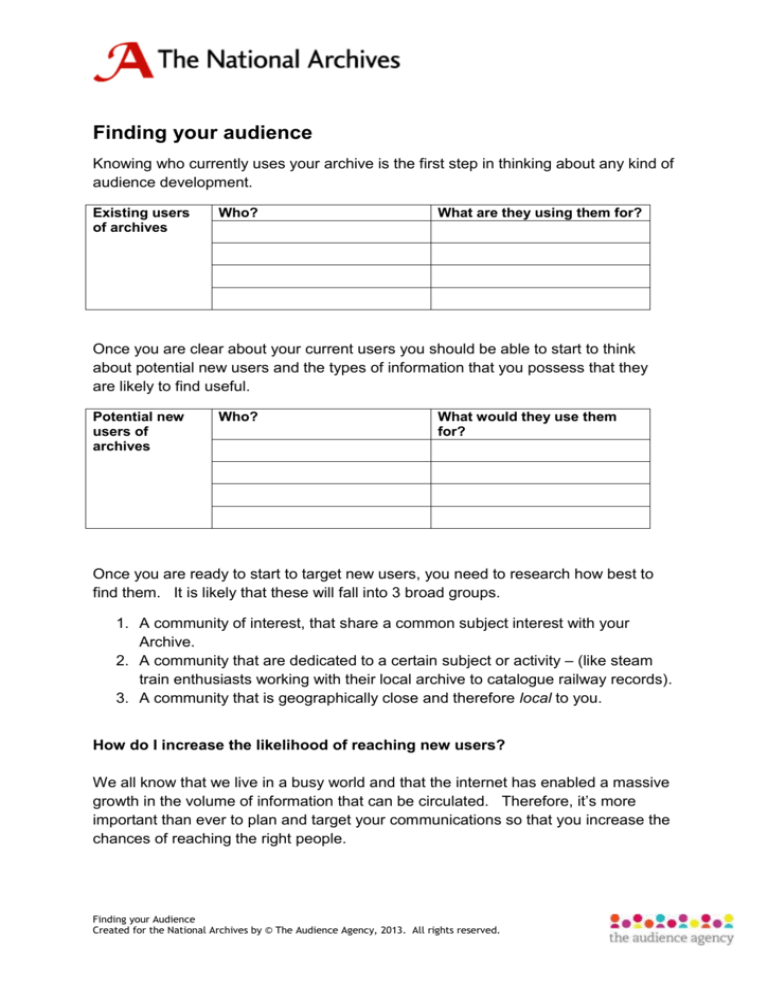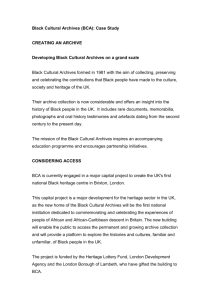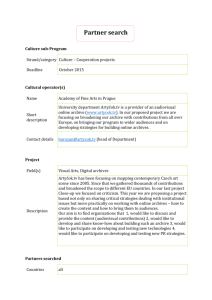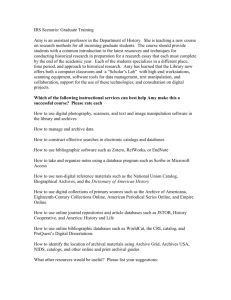
Finding your audience
Knowing who currently uses your archive is the first step in thinking about any kind of
audience development.
Existing users
of archives
Who?
What are they using them for?
Once you are clear about your current users you should be able to start to think
about potential new users and the types of information that you possess that they
are likely to find useful.
Potential new
users of
archives
Who?
What would they use them
for?
Once you are ready to start to target new users, you need to research how best to
find them. It is likely that these will fall into 3 broad groups.
1. A community of interest, that share a common subject interest with your
Archive.
2. A community that are dedicated to a certain subject or activity – (like steam
train enthusiasts working with their local archive to catalogue railway records).
3. A community that is geographically close and therefore local to you.
How do I increase the likelihood of reaching new users?
We all know that we live in a busy world and that the internet has enabled a massive
growth in the volume of information that can be circulated. Therefore, it’s more
important than ever to plan and target your communications so that you increase the
chances of reaching the right people.
Finding your Audience
Created for the National Archives by © The Audience Agency, 2013. All rights reserved.
Key recommendations
1. Think about benefits for those you’re targeting
New users are attracted by the benefits that an experience or activity will give them.
Often the person that tells them about this experience or activity will talk more about
the features than benefits and this can be off-putting particularly to someone that is
not familiar with the terminology around archives. Explore how you would talk about
what you are offering using the table below.
Features – what it is and what it offers
Benefits – what’s in it for the user/audience
e.g. A local history archive
e.g. A fun, free way of finding out more about
where they live
A potential opportunity to find out more about
their own family history (if they are local to the
area)
2. Inform your research using large public sets of data
Large public sets of data exist that can help you begin your research into where to
find target audiences. These can help you establish how large your target
audience/s may be as well as providing links to contact details. Below are some
examples of useful information sources.
Researching the Voluntary Sector:
In every urban and rural area in England, there are local infrastructure organisations
(LIOs) who are working to support local voluntary groups and organisations. There
are more than 164 000 of these support organisations in the UK and you can find
them all through NAVCA (the National Association for Voluntary and Community
Action).
Search your area here to find your local contact - http://www.navca.org.uk/directory
Bear in mind these organisations are not identical; some will cover a whole region,
county or district, so it might be worth talking to more than one.
Your LIO can tell you about
- Local voluntary and community groups (their website might even list them all).
- Local forums and partnerships – who’s working with whom?
- Local funders.
Finding your Audience
Created for the National Archives by © The Audience Agency, 2013. All rights reserved.
Researching registered Charities:
Guidestar is a free website that has details of the 168,000 registered main charities
in England and Wales. Search by postcode, keyword, or charity name to access a
range of information about charities’ activities and finances.
http://www.guidestar.org.uk/
Researching Universities and Libraries:
Making connections with students on specific courses would be a good targeted
approach to finding new communities of interest that are likely to be interested in
your archive. University courses in the UK can be searched online at
http://www.ucas.ac.uk/students/coursesearch/2013searcheu/
The Collections Trust manage a data set of the 4039 public libraries in the UK that
has recently been made public at http://data.gov.uk/dataset/uk-public-librarycontacts-14032012
JISCMail is a service for the further and higher education and research communities
that enables groups of academics and support staff to talk to each other and to share
information. There are thousands of groups covering many categories, that can be
searched at http://www.jiscmail.ac.uk/mailinglists/category/P1.html
Researching your local area:
If you’re looking to increase your users and networks in a geographical area, there
are two rich sources of information that you should start your research with;
The Office of Neighbourhood Statistics:
Use this site to access the most up to date public information about your area
including Population, Migration, Employment and Education statistics. This will help
you start to build a picture of what life is like for people living locally.
http://www.neighbourhood.statistics.gov.uk/dissemination/
Your Council:
People working within your Council will have a wealth of local contacts and
knowledge that you can tap into. It can be hard to know where to start though if
you’re not familiar with Council structures, which are very big.
Start off by finding out the names of the officers responsible for supporting,
- Cultural development including libraries
- Voluntary and community activity.
Ask them to tell you more about current local priorities and the groups locally who
are most active.
Finding your Audience
Created for the National Archives by © The Audience Agency, 2013. All rights reserved.
3. Target where there is evidence of ‘active’ behaviour happening
Once you have a baseline of the range of groups and organisations out there that
seem to have an interest in the benefits you can offer, it is useful to cement this
with a fuller picture. Find out what individual groups are planning in the next 12
months and from this you will start to see where there could be synergies and
opportunities to team up and/or develop a partnership.
4. Ask key individuals for advice
One of the most effective things you can do is ask for advice from people who are
already connected with those you are trying to target. Take time to go and meet
people or schedule a phone call specifically to ask them to share what they have
learnt and advise you on how to develop strong reciprocal relationships.
5. Get names and contact details for individuals
All information is more likely to reach its target if it is sent to a personal rather
than a generic email address. Don’t rely on contact information being up to date,
instead make calls to organisations to introduce yourself and check the
information you’re sending is being sent to the most appropriate contact. Often
the 2 minutes spent having this conversation will lead to relationships being made
more quickly and the person you’re speaking to offering useful advice about who
else to contact.
6. Create a user-friendly contacts database
It’s an obvious point but often we find the details of key contacts from past
projects have been lost somewhere along the way. Devise a clear template for
how you log contact details and circulate it to anyone working on your project.
This will enable you to easily copy details from different members of staff and add
them to one overall contacts list for your organisation.
7. Be polite and be reciprocal
Remember that any individual or organisation you contact will have their own
objectives and time pressures. Be sensitive to this, for example ask them when
would be ideal to meet or to receive the type of information you want to give them
and work to their timescales if you can. Bear in mind that if they are able to help
you it’s likely you will also be able to help them in some way too. Explore this
and try to model good practice by working with them in reciprocal ways.
Finding your Audience
Created for the National Archives by © The Audience Agency, 2013. All rights reserved.
8. Don’t be afraid to think laterally
Some of the best new relationships are born through thinking laterally about
where the people you want to reach are already accessing. Once you know who
you want to target create an ideas list of where you might find them. Targeting
these places may connect you with your target audiences more quickly.
Look out for:
- Community Centres
- Children’s centres
- Schools and Community colleges
- Out of School Clubs/Youth Clubs
- Youth Drop-in or advice centres
- Special interest groups within universities or online
- Facebook or linked in groups related to specific subjects
- Adult education venues
- Libraries and community learning centres
- GP surgeries
- Drop-ins where people go for information and advice (hostels, citizens’ advice
bureaux, information and advice centres)
- Self-help or support groups
- Lunch clubs in day centres
- Leisure and social events – tea dances, parties, outings, themed nights (ie.
Young people’s event at local cinema)
- Exercise classes such as a healthy walking club or groups meeting in leisure
centres (ask your GP)
- Churches / temples
- Faith groups
- Community rooms in housing estates/associations
- Centres/cafes/performance spaces in parks
- Noticeboards where people are posting community information – these might
be in parks, outside community venues and increasingly in supermarkets
- Online lists that record receipients of recent community funds and grants, for
example Awards for All, Heritage Lottery Fund and local trusts.
9. Keep Talking!
If you’re starting to get stuck or disheartened ask individuals who are connected to
your target audience for help. If for example you were doing local geographical
targeting you could call on the wealth of local knowledge that’s held by,
shopkeepers, caretakers, school and venue Secretaries, parks staff, community
Group members, development workers and particularly children and young people –
who are often not just hanging round, they’re taking in everything that’s going on!
Finding your Audience
Created for the National Archives by © The Audience Agency, 2013. All rights reserved.





